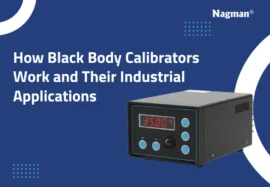Calibration is essential for modern industries and laboratories. Ensuring accuracy is crucial for the safety and efficiency of electrical instrument sensors and process control devices. A test bench is used in various industries for precision control and operation monitoring. In this blog, we discuss the evolution of test benches, their use, improvements made for automation, and the future of this technology.
Evolution of Calibration Test Benches
Calibration used to take a lot of time earlier, meaning that technicians had to work long hours and perform separate setups for each tool they used. Since all this work was done manually, the process was prone to errors, primarily due to a lack of standardisation. Test benches have undergone significant advancements in industries and laboratories today.
Today, the system has diagnostic features, intuitive operating panels and modular components. A multifunction calibrator can be used to calibrate these quickly so that it remains reliable and compatible with the standard measurement accuracy criteria. This change has led to engineers having more control over the process and decreased downtime hours while meeting international standards.
Why is a Test Bench Important?
If you’re working with instruments that need to be accurate—whether in a lab, factory, or field—a test bench is something you can’t ignore.
Think of it as your all-in-one workstation. It helps you check, calibrate, and fine-tune devices without any mess or confusion. No more jumping between tools or setups. Everything is in one place and designed to work smoothly.
Here’s why a test bench is super useful:
Makes calibration faster and easier
Lets you connect multiple instruments in one setup
Helps you test with accuracy and confidence
Works with calibration software and automation tools
Can be customized with drawers, ports, and racks
Whether you’re in a power plant or a mobile testing van, a test bench saves time, reduces errors, and keeps everything under control. It’s the backbone of any modern calibration process.
Integration of Multifunction Calibrators
The invention of multifunction calibrators has changed how industries work on a large scale. This tool serves multiple purposes, helping technicians replace individual testing devices with just one tool. Using such calibrators for testing infrastructure improves the speed of the operations at calibration facilities.
Technicians use these instruments to:
- Measure and source electrical signals such as voltage, current, and resistance
- Simulate temperature and frequency
- Work with both digital and analogue signal types
- Store and recall calibration procedures
Automation and Software Integration
Today’s calibration processes rely heavily on automation. The multifunction calibrator has advanced software applications programmed to execute specific tasks accurately. Equipment automation systems reduce human mistakes while efficiently repeating tasks to reduce workload time.
There are several benefits to automating its work, like:
- Predefined calibration routines
- Real-time data logging
- Cloud-based reporting and traceability
- Automatic pass/fail analysis
The technical team receives training to use these applications for testing tools, which can even be used to ensure compliance with standard regulations.
Mobile Calibration Systems
Mobile test benches are an essential development in this field. These portable units help the technician calibrate the field and identify equipment faults at sites where lab services cannot be accessed.
These systems are used in several different settings, such as:
- Power plants
- Oil and gas rigs
- Manufacturing floors
- Remote research facilities
The mobile test benches prevent operational disruptions and ensure accuracy and reliability standards are met in the field even without laboratory instruments.
Advancements in Test Bench Calibration Technologies
Owing to their advancements, test benches today are both quick and accurate.
Here are some innovative advancements in the field:
- AI-enabled diagnostics: High-tech systems are now being used to get equipment wear predictions, which minimises the blockages in operational processes while enabling planned calibration in advance for better allocation of resources.
- Touchscreen interfaces: Technicians use modern test benches to schedule calibration faster than ever before, thanks to the easy-to-use touchscreen interface in these tools. This reduces setup mistakes and shortens the duration of the training.
- Wireless communication: Modern calibrators can wirelessly connect to control systems to streamline cable management and provide easier remote access where troubleshooting and documentation processes may be an issue.
- Real-time cloud connectivity: The direct cloud connection allows users to upload calibration data automatically while providing live updates, and it is being monitored remotely. It even has a separate option to expand the storage memory for audit purposes.
- Enhanced multifunction calibrators: The newly released calibration tools provide improved performance, speed, precision, and accuracy so that the same instrument can handle the workload of different industries.
Conclusion
Test benches have seen significant developments since they were introduced initially, when they were operated manually, to their current state, where they have been upgraded with automated high-tech systems. The advanced test benches are quick, consistent, accurate and usable in various setups. Modern calibration techniques have also changed completely, using multifunction calibrator tools with integrated software and mobile testing systems.






